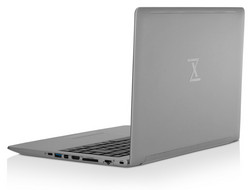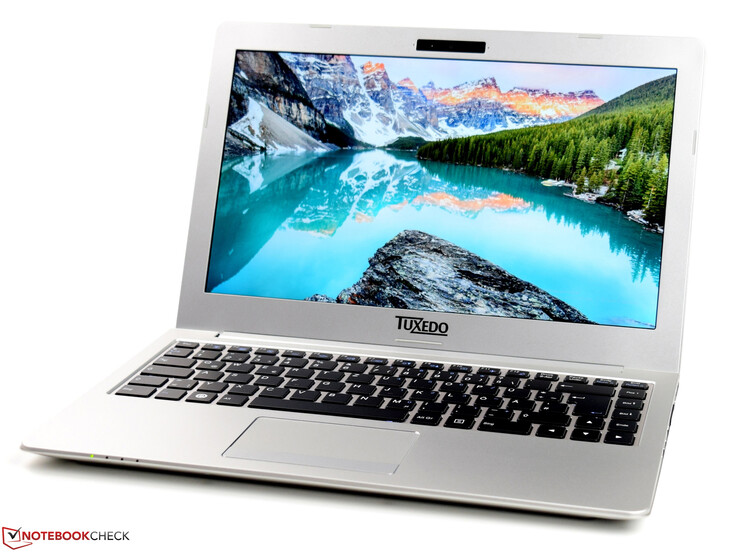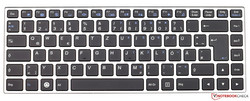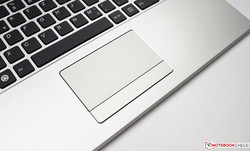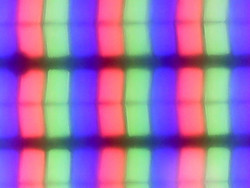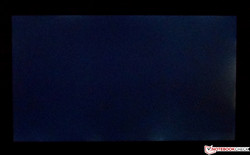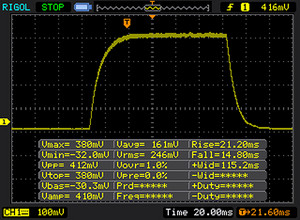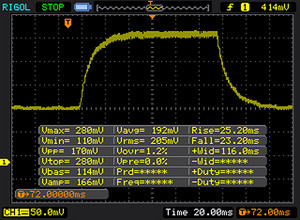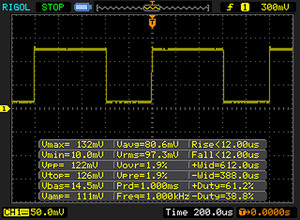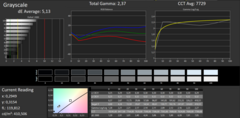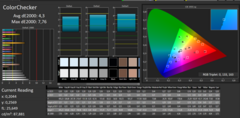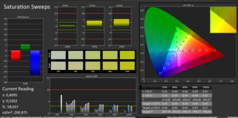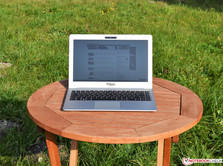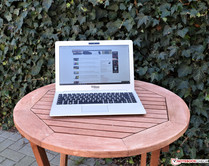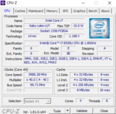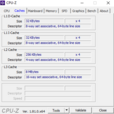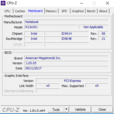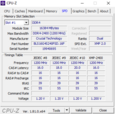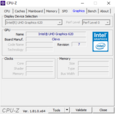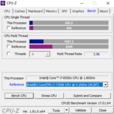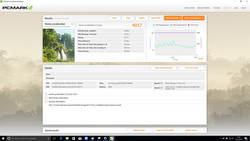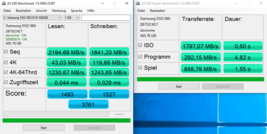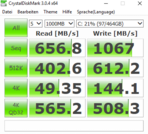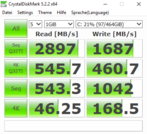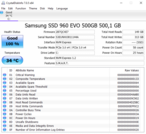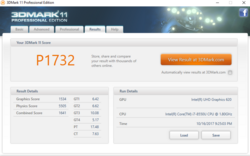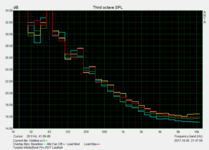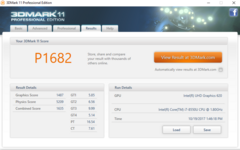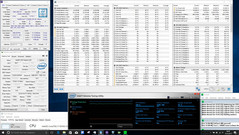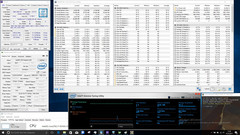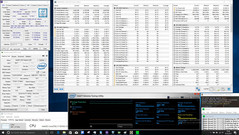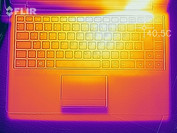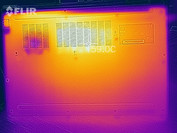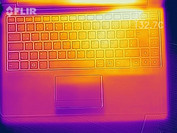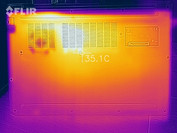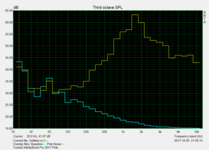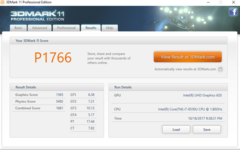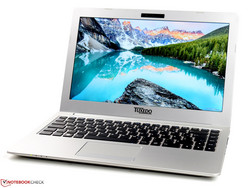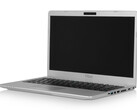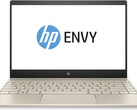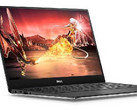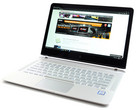Tuxedo InfinityBook Pro 13 2017 (i7-8550U, 500 GB, 32 GB, FHD) Laptop Review

For the original German review, see here.
Like its predecessor (Tuxedo InfinityBook Pro 13), the Tuxedo InfinityBook Pro 13 2017 belongs to the premium class of the compact devices in terms of performance, due to the components used. Our test unit is equipped with an Intel Core i7-8550U, a fast 512-GB SSD, and 32 GB of DDR4 RAM. In terms of the price, the current InfinityBook follows the predecessor, so that the new Kaby Lake refresh models cost about the same. Upon our request, the manufacturer confirmed this. According to the manufacturer, the base model will cost 999 Euros (~$1162) and is equipped merely with one 8-GB DDR4-RAM module and a conventional 2.5-inch hard drive. You can configure the device according to your needs on their shopping website, with the price rising quickly, depending on your selections. The device will then be configured individually and ready to be sent out within the next five business days.
The Tuxedo InfinityBook Pro 13 2017 as equipped in our test costs 1450 Euros (~$1687, without Windows). While the standard operating system of the devices is a Linux distribution, equipping them with Microsoft Windows 10 is not a problem. The corresponding drivers are included. During our tests, we also worked with the Windows operating system to maintain a single base for our benchmarks. You can see the comparison devices selected for this test in the table below, which contains the most important technical specifications. The two predecessor models of our pre-production unit are also included.
| Tuxedo InfinityBook Pro 13 | Tuxedo InfinityBook 13 v2 | HP Envy 13 | Dell XPS 13 9360 | HP Spectre 13 | |
| CPU | Intel Core i7-7500U | Intel Core i7-6500U | Intel Core i7-7500U | Intel Core i7-8550U | Intel Core i7-7500U |
| GPU | Intel HD Graphics 620 | Intel HD Graphics 620 | Intel HD Graphics 620 | Intel UHD Graphics 620 | Intel HD Graphics 620 |
| Display | 13.3 inch, 1920x1080 | 13.3 inch, 1920x1080 | 13.3 inch, 1920x1080 | 13.3 inch, 3200x1800 | 13.3 inch, 1920x1080 |
| Storage | 2x 256 GB SSD | 256 GB SSD + 250 GB SSD | 256 GB SSD | 256 GB SSD | 512 GB SSD |
| Result | 82% | 83% | 89% | 84% | 86% |
Case and Features
Compared to the Tuxedo InfinityBook Pro 13, there are no updates to the case. The base and the display lid are made from high-quality aluminum and offer a very good stability. The base cannot be twisted even when using force. With the display lid this is more easily possible, but it remains within limits. Due to the compactness, the results of the pressure tests are also very positive. When pressing on a spot at the back of the display lid, waves will not form on the display. The hinges move quite easily and you can also open the lid with one hand. After a few moments, the display will stop bouncing. The manufacturer continues to leave out a maintenance flap. In this case it does not matter much though, since you can take off the bottom without any problems. On the bottom are two wide rubber strips, which provide a secure stand and prevent the device from slipping on the surface.
At 1455 grams (3.2 lb), our test unit is the heaviest in our comparison, but the difference to the comparison devices is relatively small, so we don't see this as a disadvantage. The small power supply weighs 271 grams (~0.6 lb).
The connections are fairly decent for a device in the 13-inch format. The Tuxedo InfinityBook Pro 13 2017 offers all the important connections, which are spread over both sides of the laptop. A USB Type-C port with Thunderbolt 3 is included. These connections are definitely future-proof. Yet the device still deserves some critique, since the connections on the right side next to the USB 3.1 ports can easily become blocked. However, there is also some space on the left side for wide USB sticks in the USB 3.1 port there, which is clearly better suited for that. The card-reader (9-in-1) can work with all the usual formats. Using our reference storage card (Toshiba Exceria Pro SDXC 64 GB UHS-II), the average transfer rate when copying jpg files is 83.3 MB/s. At 85.1 MB/s during sequential reads, the Tuxedo InfinityBook Pro 13 2017 also achieved quite a good value here. However, our pre-production device is beaten by the Dell XPS 13 with its much faster UHS-II card-reader.
At 662 Mbit/s, the WLAN-performance is good and secures the first place for the Tuxedo InfinityBook Pro 13 2017 when receiving data. When sending, the performance drops slightly. But at 530 Mbit/s, our test unit still does not need to hide. Until it is ready to go into production, some adjustments may still improve the performance. The Intel Dual Band Wireless AC 8285 module supports Bluetooth version 4.2. Optionally, the Tuxedo InfinityBook Pro 13 2017 can also be equipped with an LTE module. The device offers a GBit Ethernet connector for a wired network connection.
Connections
| SD Card Reader | |
| average JPG Copy Test (av. of 3 runs) | |
| Dell XPS 13 i7-8550U | |
| Tuxedo InfinityBook Pro 13 2017 (Toshiba Exceria Pro SDXC 64 GB UHS-II) | |
| Tuxedo InfinityBook Pro 13 N130BU (Toshiba Exceria Pro SDXC 64 GB UHS-II) | |
| HP Envy 13-ad006ng (Toshiba Exceria Pro SDXC 64 GB UHS-II) | |
| Tuxedo InfinityBook 13 v2 (Toshiba Exceria Pro SDXC 64 GB UHS-II) | |
| maximum AS SSD Seq Read Test (1GB) | |
| Dell XPS 13 i7-8550U | |
| Tuxedo InfinityBook Pro 13 N130BU (Toshiba Exceria Pro SDXC 64 GB UHS-II) | |
| Tuxedo InfinityBook Pro 13 2017 (Toshiba Exceria Pro SDXC 64 GB UHS-II) | |
| HP Envy 13-ad006ng (Toshiba Exceria Pro SDXC 64 GB UHS-II) | |
| Tuxedo InfinityBook 13 v2 (Toshiba Exceria Pro SDXC 64 GB UHS-II) | |
| Networking | |
| iperf3 transmit AX12 | |
| HP Envy 13-ad006ng | |
| HP Spectre 13-v131ng | |
| Tuxedo InfinityBook Pro 13 N130BU | |
| Dell XPS 13 i7-8550U | |
| Tuxedo InfinityBook Pro 13 2017 | |
| iperf3 receive AX12 | |
| Tuxedo InfinityBook Pro 13 2017 | |
| Dell XPS 13 i7-8550U | |
| HP Envy 13-ad006ng | |
| Tuxedo InfinityBook Pro 13 N130BU | |
| HP Spectre 13-v131ng | |
Input Devices
We already know the keyboard from the predecessor. As usual, we find a penguin (Tux) on the special key instead of the Windows logo on the Tuxedo devices. The function is the same though. The keyboard offers a very comfortable typing experience. The stroke is crisp and prolific writers will be pleased. Even though the typing noise is audible, it cannot be called annoying. The keys have a size of 15 x 15 mm (0.6 x 0.6 in) and a non-slip surface. In bad light conditions, the readability of the labels is supported by the five-step background illumination. Unfortunately, we have to follow the evaluation of the predecessor for the touchpad. At 9 x 4.7 cm (~3.5 x 1.85 in), the input surface is quite small and the surface does not offer good gliding characteristics, which makes navigating the menus harder. The two separate input keys produce a quiet acoustic feedback for the user. With this size of the laptop, perhaps it would have been better to use a ClickPad, since this would have offered a considerably larger input surface. In our function test, the touchpad cannot keep up the good visual impression we had with the quality of the device.
Display
We already know the built-in display from the Tuxedo InfinityBook Pro 13. In the update of the InfinityBook, we also find a matte 13.3-inch IPS panel with a resolution of 1920x1080 pixels. Alternatively, the Tuxedo InfinityBook Pro 13 2017 can also be equipped with a QHD+ IPS panel (+ 139 Euros, ~$164). Due to the manufacturing tolerances, the measured results are slightly different. In the context of our measurements, the test unit achieves an average display brightness of 370 cd/m². At 81%, the brightness distribution is rather below average. Our test unit achieves a black value of 0.36, which in combination with the good brightness achieves a contrast ratio of 1150:1. We did notice some clouding in the areas on the edges, which is not noticeable during regular usage, though. We measured PWM with a frequency of 1000 Hz. Due to the high frequency, which also only appears at a display brightness of 20%, there should not be any interference.
| |||||||||||||||||||||||||
Brightness Distribution: 81 %
Center on Battery: 417 cd/m²
Contrast: 1150:1 (Black: 0.36 cd/m²)
ΔE ColorChecker Calman: 4.3 | ∀{0.5-29.43 Ø4.78}
ΔE Greyscale Calman: 5.13 | ∀{0.09-98 Ø5}
99% sRGB (Argyll 1.6.3 3D)
64% AdobeRGB 1998 (Argyll 1.6.3 3D)
69.6% AdobeRGB 1998 (Argyll 3D)
98.9% sRGB (Argyll 3D)
67.8% Display P3 (Argyll 3D)
Gamma: 2.37
CCT: 7729 K
| Tuxedo InfinityBook Pro 13 2017 LC133LF2L01, IGZO TFT-LCD, 1920x1080, 13.3" | Tuxedo InfinityBook Pro 13 N130BU LC133LF2L01 , 1920x1080, 13.3" | Tuxedo InfinityBook 13 v2 Chi Mei N133HSE-EA3, 1920x1080, 13.3" | HP Envy 13-ad006ng BOE070E, 1920x1080, 13.3" | Dell XPS 13 i7-8550U ID: Sharp SHP144A, Name: LQ133Z1, 3200x1800, 13.3" | HP Spectre 13-v131ng CMN1374, 1920x1080, 13.3" | |
|---|---|---|---|---|---|---|
| Display | 1% | -12% | -8% | -6% | -7% | |
| Display P3 Coverage (%) | 67.8 | 69.3 2% | 68.3 1% | 66.8 -1% | 63.6 -6% | 64.6 -5% |
| sRGB Coverage (%) | 98.9 | 97.8 -1% | 67 -32% | 86.3 -13% | 93 -6% | 88.8 -10% |
| AdobeRGB 1998 Coverage (%) | 69.6 | 70.6 1% | 67 -4% | 63.1 -9% | 65.4 -6% | 64.8 -7% |
| Response Times | 11% | 25% | 5% | 24% | 5% | |
| Response Time Grey 50% / Grey 80% * (ms) | 48 ? | 41 ? 15% | 34 ? 29% | 48 ? -0% | 35.6 ? 26% | 46 ? 4% |
| Response Time Black / White * (ms) | 35 ? | 33 ? 6% | 27.6 ? 21% | 32 ? 9% | 27.2 ? 22% | 33 ? 6% |
| PWM Frequency (Hz) | 1000 ? | 1000 | 200 ? | 1000 ? | 19690 ? | |
| Screen | 1% | -6% | -10% | -2% | -8% | |
| Brightness middle (cd/m²) | 414 | 471 14% | 357 -14% | 281 -32% | 386.1 -7% | 404 -2% |
| Brightness (cd/m²) | 370 | 427 15% | 355 -4% | 264 -29% | 357 -4% | 382 3% |
| Brightness Distribution (%) | 81 | 82 1% | 90 11% | 83 2% | 83 2% | 91 12% |
| Black Level * (cd/m²) | 0.36 | 0.44 -22% | 0.34 6% | 0.23 36% | 0.33 8% | 0.35 3% |
| Contrast (:1) | 1150 | 1070 -7% | 1050 -9% | 1222 6% | 1170 2% | 1154 0% |
| Colorchecker dE 2000 * | 4.3 | 4.12 4% | 5.4 -26% | 4.83 -12% | 4.2 2% | 5.37 -25% |
| Colorchecker dE 2000 max. * | 7.76 | 7.95 -2% | 7.81 -1% | 8.89 -15% | 7.6 2% | 9.46 -22% |
| Greyscale dE 2000 * | 5.13 | 4.49 12% | 5.59 -9% | 6.63 -29% | 5.7 -11% | 6.44 -26% |
| Gamma | 2.37 93% | 2.33 94% | 2.14 103% | 1.85 119% | 2.28 96% | 2.52 87% |
| CCT | 7729 84% | 7196 90% | 5839 111% | 6794 96% | 7336 89% | 6738 96% |
| Color Space (Percent of AdobeRGB 1998) (%) | 64 | 64 0% | 59.45 -7% | 56 -12% | 59 -8% | 58 -9% |
| Color Space (Percent of sRGB) (%) | 99 | 98 -1% | 91.32 -8% | 86 -13% | 92.2 -7% | 89 -10% |
| Total Average (Program / Settings) | 4% /
2% | 2% /
-3% | -4% /
-7% | 5% /
1% | -3% /
-6% |
* ... smaller is better
Display Response Times
| ↔ Response Time Black to White | ||
|---|---|---|
| 35 ms ... rise ↗ and fall ↘ combined | ↗ 21 ms rise | |
| ↘ 14 ms fall | ||
| The screen shows slow response rates in our tests and will be unsatisfactory for gamers. In comparison, all tested devices range from 0.1 (minimum) to 240 (maximum) ms. » 92 % of all devices are better. This means that the measured response time is worse than the average of all tested devices (20.2 ms). | ||
| ↔ Response Time 50% Grey to 80% Grey | ||
| 48 ms ... rise ↗ and fall ↘ combined | ↗ 25 ms rise | |
| ↘ 23 ms fall | ||
| The screen shows slow response rates in our tests and will be unsatisfactory for gamers. In comparison, all tested devices range from 0.165 (minimum) to 636 (maximum) ms. » 82 % of all devices are better. This means that the measured response time is worse than the average of all tested devices (31.6 ms). | ||
Screen Flickering / PWM (Pulse-Width Modulation)
| Screen flickering / PWM detected | 1000 Hz | ≤ 20 % brightness setting | |
The display backlight flickers at 1000 Hz (worst case, e.g., utilizing PWM) Flickering detected at a brightness setting of 20 % and below. There should be no flickering or PWM above this brightness setting. The frequency of 1000 Hz is quite high, so most users sensitive to PWM should not notice any flickering. In comparison: 53 % of all tested devices do not use PWM to dim the display. If PWM was detected, an average of 8101 (minimum: 5 - maximum: 343500) Hz was measured. | |||
The display quality offered is good. The reproduced image is sharp and the 100% scaling fits very well with the 13.3-inch diagonal and the Full HD resolution. At 4.3 (DeltaE2000 ColorChecker) and 5.13 (DeltaE2000 Grayscales), the color deviations are a bit high. The color-space coverage is fairly decent at 99% sRGB and 64% AdobeRGB. The comparison devices cannot quite keep up with this. Due to its compactness, the device is excellently suited for work anywhere and at any time. However, we recommend finding a shady place for work outdoors.
The viewing-angle test shows the typical strengths and weaknesses of an IPS panel. The high viewing-angle stability is clearly a strength. Yet the four corner images are still slightly veiled, which is not unusual, though. Since this viewing angle is not common, there is no interference in everyday usage. The test image can be seen easily from all viewing angles.
Performance
The Tuxedo InfinityBook Pro 13 2017 is a small notebook which is excellently suited for work. The fast Intel Core i7-8550U with its four cores offers a very high computing performance to master everyday tasks. With 32-GB DDR4 RAM, our test unit possesses a lot of working memory which is an advantage especially for virtual machines. Anyone who can do without VMs may also be content with the minimum equipment of 8 GB. A fast M.2 SSD serves as the storage in our test unit. More affordable alternatives are also available here. Our recommendation trends clearly towards an SSD, whether it has an M.2 or SATA connection, since the performance advantage to a regular hard drive is simply huge.
Processor
The built-in processor taking the place of the Intel Core i7-7500U is the great new improvement in the Tuxedo InfinityBook Pro 13 2017. With the same TDP, the Intel Core i7-8550U now offers four computing cores instead of two. With this, the small SoC can run eight threads simultaneously, thanks to Hyper-Threading. Converting this to numbers, it means that the performance compared to the predecessor could be increased by 83% in multithread applications. The single-core performance could be increased slightly as well, and the Tuxedo InfinityBook Pro 13 2017 achieved a plus of 8% here. Unfortunately, our Tuxedo InfinityBook Pro 13 2017 loses the duel with the Dell XPS 13. Due to the large range in the clock speeds (1.8 – 4.0 GHz), there can be considerable differences in the performance. A well-functioning cooling system is the key here. In the Tuxedo InfinityBook Pro 13 2017, we observe a clock speed of 2.6 GHz right after the start of the Cinebench-R15 multi test, which cannot be stably maintained, though. Continuing, the clock speed varies between 1.9 and 2.5, while we did not observe it lowering below the base clock speed of 1.8 GHz.
You can find further benchmarks on the Intel Core i7-8550U here.
The constant load with the Cinebench-R15 multi loop clearly shows that the performance of the processor is reduced considerably during high loads. While it is still about 550 points in the first run, the result falls to about 470 points in the second run. All further runs then remain on the same level, though. The short-term performance of the processor is 14% higher than that under constant load. Yet, the performance under constant load is not something to scoff at, since the HP Spectre only achieved about 280 points in this test.
| Cinebench R15 | |
| CPU Single 64Bit | |
| Dell XPS 13 i7-8550U | |
| Tuxedo InfinityBook Pro 13 2017 | |
| HP Envy 13-ad006ng | |
| Tuxedo InfinityBook Pro 13 N130BU | |
| HP Spectre 13-v131ng | |
| Tuxedo InfinityBook 13 v2 | |
| CPU Multi 64Bit | |
| Dell XPS 13 i7-8550U | |
| Tuxedo InfinityBook Pro 13 2017 | |
| HP Envy 13-ad006ng | |
| Tuxedo InfinityBook 13 v2 | |
| HP Spectre 13-v131ng | |
| Tuxedo InfinityBook Pro 13 N130BU | |
| JetStream 1.1 - Total Score | |
| Tuxedo InfinityBook Pro 13 2017 | |
| Tuxedo InfinityBook Pro 13 N130BU | |
| HP Spectre 13-v131ng | |
| Tuxedo InfinityBook 13 v2 | |
| HP Envy 13-ad006ng | |
System Performance
We compare the system performance of the test units with PCMark8 Home. Here, the Tuxedo InfinityBook Pro 13 2017 takes first place with an advantage of 6% and 4017 points. The performance of the Dell XPS 13, which gets the second-to-last place with only 3432 points, is slightly disappointing here. During the time period of our testing, there were no complaints about the system performance at all.
| PCMark 8 - Home Score Accelerated v2 | |
| Tuxedo InfinityBook Pro 13 2017 | |
| HP Spectre 13-v131ng | |
| HP Envy 13-ad006ng | |
| Tuxedo InfinityBook Pro 13 N130BU | |
| Dell XPS 13 i7-8550U | |
| Tuxedo InfinityBook 13 v2 | |
| PCMark 8 Home Score Accelerated v2 | 4017 points | |
Help | ||
Storage Solution
The storage solution, in the form of an M.2 SSD, is made by Samsung. The Samsung 960 Evo offers 500 GB of storage space and also does well in the benchmarks. We measure the results with AS SSD, and the sequential read speed is 2194 MB/s. While writing, it still achieves a speed of 1641 MB/s. The 4K-read values are very good at 43 MB/s. In particular, the system start profits from this. An unoccupied 2.5-inch slot offers the opportunity to add more data storage to the device. The configuration options offer a maximum of 4 TB. In the comparison, the Tuxedo InfinityBook Pro 13 2017 with the Samsung 960 Evo is the clear winner here, and only the HP Spectre, which also has a fast Samsung SSD, can halfway keep up with this.
| Tuxedo InfinityBook Pro 13 2017 Samsung SSD 960 Evo 500GB m.2 NVMe | Tuxedo InfinityBook Pro 13 N130BU 2x Samsung SM961 MZVPW256HEGL NVMe (RAID 0) | Tuxedo InfinityBook 13 v2 Samsung SSD 950 Pro 256GB m.2 NVMe | HP Envy 13-ad006ng Toshiba NVMe THNSN5256GPUK | Dell XPS 13 i7-8550U Toshiba XG5 KXG50ZNV256G | HP Spectre 13-v131ng Samsung PM961 NVMe MZVLW512HMJP | |
|---|---|---|---|---|---|---|
| AS SSD | -62% | -22% | -96% | -66% | -3% | |
| Seq Read (MB/s) | 2195 | 1922 -12% | 2011 -8% | 1369 -38% | 1277 -42% | 1325 -40% |
| Seq Write (MB/s) | 1641 | 1180 -28% | 909 -45% | 247.8 -85% | 249.2 -85% | 1190 -27% |
| 4K Read (MB/s) | 43.03 | 24.06 -44% | 46.73 9% | 31.22 -27% | 28.17 -35% | 56.4 31% |
| 4K Write (MB/s) | 119.7 | 51.6 -57% | 115.6 -3% | 89.4 -25% | 101.7 -15% | 134.4 12% |
| 4K-64 Read (MB/s) | 1231 | 1816 48% | 703 -43% | 616 -50% | 423.6 -66% | 1465 19% |
| 4K-64 Write (MB/s) | 1244 | 605 -51% | 300 -76% | 66.7 -95% | 325.1 -74% | 862 -31% |
| Access Time Read * (ms) | 0.044 | 0.077 -75% | 0.045 -2% | 0.233 -430% | 0.102 -132% | 0.042 5% |
| Access Time Write * (ms) | 0.029 | 0.109 -276% | 0.032 -10% | 0.034 -17% | 0.051 -76% | 0.026 10% |
* ... smaller is better
Graphics Card
An Intel UHD Graphics 620 takes care of the graphics output. Compared to the similarly equipped Dell XPS 13, the Tuxedo InfinityBook Pro 13 2017 achieves almost 300 points less in the 3DMark 11 test. The HP Envy 13 with the dedicated Nvidia GeForce MX 150 clearly leads the field in this test section. The Intel UHD Graphics 620 mainly serves to support the processor when reproducing high-resolution videos, since H.265/HEVC in the Main10 profile with 10-bit color depth as well as Google's VP9 codec can be decoded in the hardware.
You can find further information and benchmarks on the Intel UHD Graphics 620 here.
| 3DMark 11 - 1280x720 Performance GPU | |
| HP Envy 13-ad006ng | |
| Dell XPS 13 i7-8550U | |
| HP Spectre 13-v131ng | |
| Tuxedo InfinityBook Pro 13 2017 | |
| Tuxedo InfinityBook 13 v2 | |
| 3DMark 06 Standard Score | 12051 points | |
| 3DMark 11 Performance | 1732 points | |
Help | ||
Gaming Performance
3D games should not be the prevailing tasks if you decide to choose such a device. In the test, BioShock Infinite could only be displayed smoothly in the lowest presets. However, casual gaming and simple browser games should not be too difficult for our device.
| low | med. | high | ultra | |
|---|---|---|---|---|
| BioShock Infinite (2013) | 68.7 | 30.9 | 26.4 | 9.6 |
Emissions and Power Management
Noise Emissions
The background noises of the Tuxedo InfinityBook Pro 13 2017 are very restrained. The device runs completely silent for a long time, and the fan starts running only under load. Still, the device remains very quiet at 31 dB(A) even under full load. This is a clear advantage for the Tuxedo InfinityBook Pro 13 2017, since the comparison devices are, in parts, considerably louder under load.
| Tuxedo InfinityBook Pro 13 2017 UHD Graphics 620, i5-8550U, Samsung SSD 960 Evo 500GB m.2 NVMe | Tuxedo InfinityBook Pro 13 N130BU HD Graphics 620, i7-7500U, 2x Samsung SM961 MZVPW256HEGL NVMe (RAID 0) | Tuxedo InfinityBook 13 v2 HD Graphics 520, 6500U, Samsung SSD 950 Pro 256GB m.2 NVMe | HP Envy 13-ad006ng GeForce MX150, i7-7500U, Toshiba NVMe THNSN5256GPUK | Dell XPS 13 i7-8550U UHD Graphics 620, i5-8550U, Toshiba XG5 KXG50ZNV256G | HP Spectre 13-v131ng HD Graphics 620, i7-7500U, Samsung PM961 NVMe MZVLW512HMJP | |
|---|---|---|---|---|---|---|
| Noise | -6% | -7% | -5% | 4% | -10% | |
| off / environment * (dB) | 30.1 | 30.8 -2% | 29 4% | 30.5 -1% | 27.9 7% | 30.4 -1% |
| Idle Minimum * (dB) | 30.1 | 31 -3% | 29 4% | 30.5 -1% | 27.9 7% | 30.4 -1% |
| Idle Average * (dB) | 30.1 | 31 -3% | 29 4% | 30.5 -1% | 27.9 7% | 30.4 -1% |
| Idle Maximum * (dB) | 30.7 | 31 -1% | 29 6% | 30.5 1% | 27.9 9% | 30.4 1% |
| Load Average * (dB) | 31 | 34.9 -13% | 34.6 -12% | 37.3 -20% | 30.8 1% | 40 -29% |
| Load Maximum * (dB) | 31 | 34.9 -13% | 46.1 -49% | 34.2 -10% | 33.1 -7% | 40 -29% |
| Witcher 3 ultra * (dB) | 37.3 |
* ... smaller is better
Noise level
| Idle |
| 30.1 / 30.1 / 30.7 dB(A) |
| Load |
| 31 / 31 dB(A) |
 | ||
30 dB silent 40 dB(A) audible 50 dB(A) loud |
||
min: | ||
Temperature
Under load, the case warms up quite a lot. We measure the highest value at the bottom with 50.4 °C (123 °F). With this, working on your lap with a full system load can become uncomfortable sometimes. Without load, the case temperature does not rise above 30 °C (86 °F). During the stress test with Prime95, the Intel Core i7-8550U reaches a maximum core temperature of 83 °C (181 °F). The average clock speed levels out at 1.8 GHz, which corresponds almost exactly to the base core speed of the processor. We did not observe any longer lowering beyond this. Thus only the power target, which lies at 15 watts, takes hold. The small SoC only gets 44 watts for short periods of time. Thermal-throttling was not an issue in our test unit. However, during simultaneous loads of the system with Prime95 and Furmark, the base clock speed could not be maintained. CPU and GPU have to share the TDP of 15 watts, causing the processor to be unable to offer more performance. The 3D performance was not impacted by the stress test.
(±) The maximum temperature on the upper side is 42.3 °C / 108 F, compared to the average of 35.9 °C / 97 F, ranging from 21.4 to 59 °C for the class Subnotebook.
(-) The bottom heats up to a maximum of 50.4 °C / 123 F, compared to the average of 39.3 °C / 103 F
(+) In idle usage, the average temperature for the upper side is 25.6 °C / 78 F, compared to the device average of 30.8 °C / 87 F.
(+) The palmrests and touchpad are cooler than skin temperature with a maximum of 30.1 °C / 86.2 F and are therefore cool to the touch.
(±) The average temperature of the palmrest area of similar devices was 28.2 °C / 82.8 F (-1.9 °C / -3.4 F).
| Tuxedo InfinityBook Pro 13 2017 UHD Graphics 620, i5-8550U, Samsung SSD 960 Evo 500GB m.2 NVMe | Tuxedo InfinityBook Pro 13 N130BU HD Graphics 620, i7-7500U, 2x Samsung SM961 MZVPW256HEGL NVMe (RAID 0) | Tuxedo InfinityBook 13 v2 HD Graphics 520, 6500U, Samsung SSD 950 Pro 256GB m.2 NVMe | HP Envy 13-ad006ng GeForce MX150, i7-7500U, Toshiba NVMe THNSN5256GPUK | Dell XPS 13 i7-8550U UHD Graphics 620, i5-8550U, Toshiba XG5 KXG50ZNV256G | HP Spectre 13-v131ng HD Graphics 620, i7-7500U, Samsung PM961 NVMe MZVLW512HMJP | |
|---|---|---|---|---|---|---|
| Heat | 7% | -5% | 17% | -4% | -1% | |
| Maximum Upper Side * (°C) | 42.3 | 41.7 1% | 39.6 6% | 41.6 2% | 49 -16% | 54.2 -28% |
| Maximum Bottom * (°C) | 50.4 | 44.4 12% | 42.3 16% | 33.4 34% | 54 -7% | 37.7 25% |
| Idle Upper Side * (°C) | 27.4 | 26.1 5% | 33.7 -23% | 23.1 16% | 26.6 3% | 29 -6% |
| Idle Bottom * (°C) | 29.2 | 26.6 9% | 34.4 -18% | 24.1 17% | 28.2 3% | 27.6 5% |
* ... smaller is better
Speakers
The manufacturer should also think about some reworking of the speakers. Compared to the predecessor, nothing has changed. The highs and mids are prevalent and the bass is non-existent. At 68 dB(A), the maximum volume is not loud. But even then, it quickly becomes uncomfortable due to the overemphasized highs. The speakers are not recommendable for a longer period of time.
Tuxedo InfinityBook Pro 13 2017 audio analysis
(-) | not very loud speakers (63.2 dB)
Bass 100 - 315 Hz
(±) | reduced bass - on average 12.1% lower than median
(+) | bass is linear (6.1% delta to prev. frequency)
Mids 400 - 2000 Hz
(±) | higher mids - on average 8.2% higher than median
(±) | linearity of mids is average (12% delta to prev. frequency)
Highs 2 - 16 kHz
(+) | balanced highs - only 3.6% away from median
(±) | linearity of highs is average (8.4% delta to prev. frequency)
Overall 100 - 16.000 Hz
(-) | overall sound is not linear (30.6% difference to median)
Compared to same class
» 92% of all tested devices in this class were better, 2% similar, 6% worse
» The best had a delta of 5%, average was 18%, worst was 53%
Compared to all devices tested
» 89% of all tested devices were better, 3% similar, 9% worse
» The best had a delta of 4%, average was 24%, worst was 134%
Dell XPS 13 i7-8550U audio analysis
(-) | not very loud speakers (66.8 dB)
Bass 100 - 315 Hz
(+) | good bass - only 4.5% away from median
(±) | linearity of bass is average (8.2% delta to prev. frequency)
Mids 400 - 2000 Hz
(±) | higher mids - on average 5% higher than median
(+) | mids are linear (5.8% delta to prev. frequency)
Highs 2 - 16 kHz
(+) | balanced highs - only 3% away from median
(±) | linearity of highs is average (14.5% delta to prev. frequency)
Overall 100 - 16.000 Hz
(±) | linearity of overall sound is average (17.2% difference to median)
Compared to same class
» 43% of all tested devices in this class were better, 9% similar, 48% worse
» The best had a delta of 5%, average was 18%, worst was 53%
Compared to all devices tested
» 31% of all tested devices were better, 8% similar, 61% worse
» The best had a delta of 4%, average was 24%, worst was 134%
Frequency comparison (checkboxes selectable!)
Power Consumption
During idle, the power consumption of the system is 4.5 to 10.6 watts, which is slightly more than the predecessor. Under load, the power consumption climbs to a maximum of 38 watts, leveling out at 36.1 watts on average. Here the Tuxedo InfinityBook Pro 13 2017 is beaten by the competition. Since this is a pre-production model, some improvements could still be made via BIOS optimization. The power supply provides a maximum of 40 watts, which is sufficient. We did not notice any discharging of the battery during loads.
| Off / Standby | |
| Idle | |
| Load |
|
Key:
min: | |
| Tuxedo InfinityBook Pro 13 2017 UHD Graphics 620, i5-8550U, Samsung SSD 960 Evo 500GB m.2 NVMe | Tuxedo InfinityBook Pro 13 N130BU HD Graphics 620, i7-7500U, 2x Samsung SM961 MZVPW256HEGL NVMe (RAID 0) | Tuxedo InfinityBook 13 v2 HD Graphics 520, 6500U, Samsung SSD 950 Pro 256GB m.2 NVMe | HP Envy 13-ad006ng GeForce MX150, i7-7500U, Toshiba NVMe THNSN5256GPUK | Dell XPS 13 i7-8550U UHD Graphics 620, i5-8550U, Toshiba XG5 KXG50ZNV256G | HP Spectre 13-v131ng HD Graphics 620, i7-7500U, Samsung PM961 NVMe MZVLW512HMJP | |
|---|---|---|---|---|---|---|
| Power Consumption | 13% | -10% | 7% | 11% | 14% | |
| Idle Minimum * (Watt) | 4.5 | 2.8 38% | 6 -33% | 2.8 38% | 4.1 9% | 3.6 20% |
| Idle Average * (Watt) | 8.2 | 6.4 22% | 10.3 -26% | 5.8 29% | 5.8 29% | 6.4 22% |
| Idle Maximum * (Watt) | 10.6 | 10.5 1% | 11 -4% | 7.7 27% | 6 43% | 9.2 13% |
| Load Average * (Watt) | 36.1 | 30 17% | 31.2 14% | 48 -33% | 42.5 -18% | 34 6% |
| Load Maximum * (Watt) | 38 | 42 -11% | 38.4 -1% | 48 -26% | 41.4 -9% | 34.4 9% |
| Witcher 3 ultra * (Watt) | 35 |
* ... smaller is better
Battery Life
The higher power requirements also cause a much shorter battery life in our pre-production device. Here as well, optimizations to save some power could lead to a longer battery life. In the practically relevant WLAN test, one battery charge was able to provide the device with power for 4:37 hours. For similar test conditions, the brightness of the display was lowered by seven steps, which corresponds to a display brightness of 150 cd/m². Charging the battery afterwards took 171 minutes.
| Tuxedo InfinityBook Pro 13 2017 i5-8550U, UHD Graphics 620, 36 Wh | Tuxedo InfinityBook Pro 13 N130BU i7-7500U, HD Graphics 620, 36 Wh | Tuxedo InfinityBook 13 v2 6500U, HD Graphics 520, 45 Wh | HP Envy 13-ad006ng i7-7500U, GeForce MX150, 51 Wh | Dell XPS 13 i7-8550U i5-8550U, UHD Graphics 620, 60 Wh | HP Spectre 13-v131ng i7-7500U, HD Graphics 620, 38 Wh | |
|---|---|---|---|---|---|---|
| Battery Runtime | ||||||
| WiFi Websurfing (h) | 4.6 | 7.5 63% | 5.6 22% | 7.1 54% | 9.8 113% | 6.6 43% |
Pros
Cons
Verdict
The Tuxedo InfinityBook Pro 13 2017 is an elegant and robust sub-notebook. The manufacturer has performed product maintenance and retired the seventh generation of the Core-i series. The eighth generation offers a decent performance increase, assuring a high operating speed throughout. For a moderate starting price of 999 Euros (~$1162) the customers receive a very good and silent workhorse, which is also well-built. Our test unit with the maximum amount of RAM and a very fast storage drive costs 1450 Euros (~$1687).
The Tuxedo InfinityBook Pro 13 2017 convinces us with a high operating speed and versatile configuration options. Linux fans will be happy about the device for a long time, since the Tuxedo InfinityBook Pro 13 2017 can handle the most common Linux distributions.
We also remember the suitable keyboard which offers a good typing experience. Even though the Tuxedo InfinityBook Pro 13 2017 scores with a display that has stable viewing angles, overall the rather average measurement results reduce the total points. We see room for catching up in terms of the touchpad and speakers, which do not fit the overall concept in their current forms.
Tuxedo InfinityBook Pro 13 2017
- 10/25/2017 v6 (old)
Sebastian Bade




